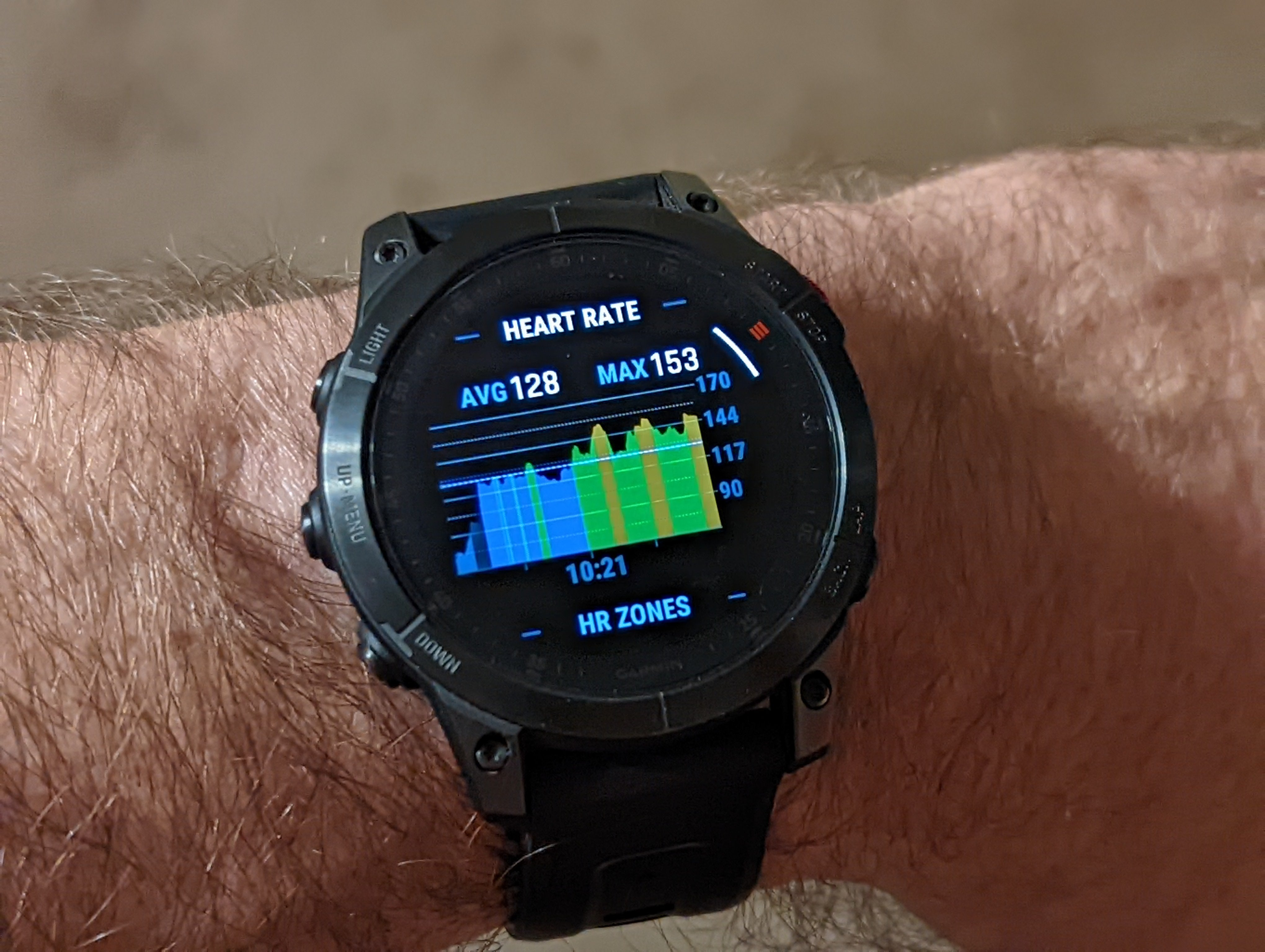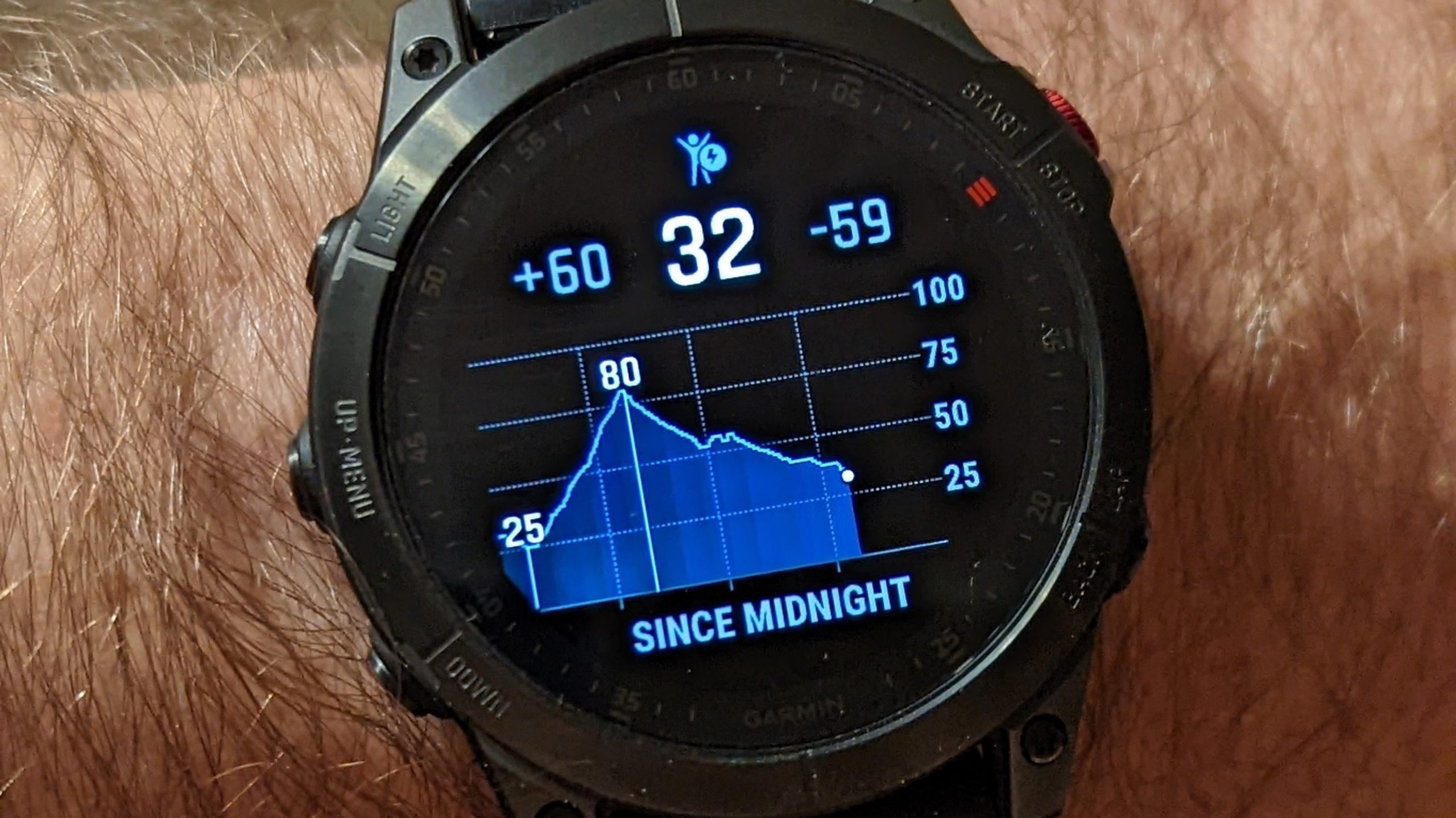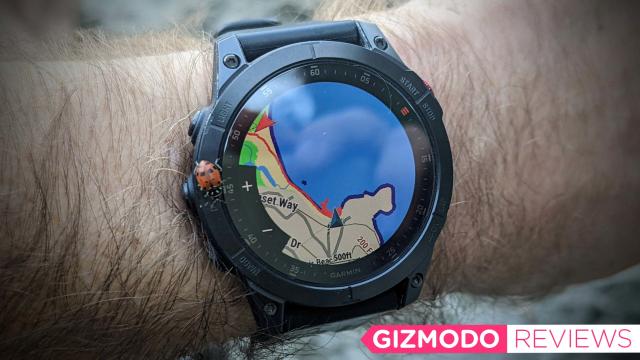I’ve been reviewing wearables for a solid decade now, and in that time, the Garmin Fenix line has emerged as the best multi-sport watch and activity tracker. Year after year, the Fenix has managed to stay either a little or a lot ahead of the competition, and when I heard the Fenix 7 was coming down the pipeline, I was sure it was going to be my new favourite fitness watch. But it isn’t — the new Garmin Epix is.
The Epix is basically a Fenix 7 but with a stunning AMOLED screen, which means you do have to sacrifice some battery life. Other than that, the two new watches are effectively identical. I tested both the Fenix 7 and the Epix (Sapphire editions for both), so we’ll get into the hair-splitting differences, but for now know that in almost every way they are the same watch. It’s worth noting that Garmin made a watch called the Epix back in 2015 that was a bit clunky. It’s an odd choice for the company to have revived that name, rather than calling it the Fenix 7 AMOLED edition or something, but whatever. The Epix we’re talking about here may be referred to as Gen 2, but since basically nobody remembers the original one we’re just going to call it the Epix for this review.

Garmin Epix
What is it?
Garmin's new flagship watch
Price
$1,399 (or $1,499 for Sapphire edition)
Like
Absolutely gorgeous display, which finally has touch, making mapping and navigating a lot easier; new heart rate sensors and GPS technology for improved accuracy; ski maps even show the names of runs; lower-profile than previous generation
Don't like
Battery life takes a hit because of screen; Garmin Connect app has lots of details, but it’s still not intuitive to use; confusing to add music, workouts, and routes to watch
A Health-Tracking Machine
For those unfamiliar with the Fenix line, it’s basically Garmin’s “track everything” GPS sports watch. It can track more than 60 different sports and activities out of the box — everything from running to open water swimming to snowboarding to pickleball. If your chosen activity isn’t in that list there’s a decent chance a third-party developer has made an app for it that you can download from the Garmin Connect store (a limited version of which is now built into the watch, in addition to the full version on your phone).
The Fenix also excels at the 24/7 health-monitoring stuff we expect from Fitbits and other smartwatches. This includes constantly monitoring your heart rate, your steps, floors climbed, stress levels, Body Battery (which measures recovery, similar to Whoop), sleep, and even blood oxygen levels. For running and cycling there’s a new real-time Stamina feature, which basically shows you how much energy the watch thinks you have going into a workout, and it continuously updates as you go, basically showing you how much push you’ve still got left in you. You can use this to try to keep from over-extending (or under-extending) yourself, at least from a cardiovascular perspective (your joints may say otherwise).

All of the heart rate-related metrics are tracked with Garmin’s new Elevate 4 sensor suite, which debuted last year on the Venu 2 watch (which I didn’t particularly care for). The suite is now encased in glass instead of plastic, which should increase durability and keep it accurate over time. The Fenix now has four infrared sensors, up from two, to go along with the two green and one red LED lights. The red lights are for pulse oximetry, which I just test manually from time to time, but you can choose to have it on all night while you sleep (if you’re worried about things like sleep apnea) or 24/7, but battery life will take a hit. Generally, I found my heart rate tracking to be extremely accurate (compared to a Wahoo chest strap I wore, too), even during rigorous activity, and the pulse ox was right in line with the medical-grade finger-clip device I own.
Improved GPS
While all of the Epix and Fenix watches can access multiple global navigation satellite systems (GPS, GLONASS, and Galileo satellite systems), the Sapphire editions are among the first watches to support multi-band GNSS.
What this means is that each of those satellites broadcast in multiple frequencies, and typically your watch only picks up one of them. Multi-band means that your watch is picking up multiple frequencies from each individual satellite, which in theory will give you the best possible accuracy. In practice, I didn’t see a huge amount of difference from the standard GNSS system, but I wasn’t hiking through any canyons or running between skyscrapers. Multi-band is also a very new system and will continue to improve with time. I will say, however, that I found satellite acquisition to be faster than it is on any sports watch I’ve tested before. It’s not uncommon for me to load up the run app, and then have to wait a minute for it to find satellites. With the Epix (and Fenix), it almost always had me locked in and ready to go in under 10 seconds.
Classic Design With an Incredible Display
Out in the real world, the Epix is a joy to use. The 1.3-inch AMOLED display is bright and vibrant. I had zero difficulty reading it even in blinding sunlight. It was easier to read than the Fenix 7 in all conditions, but even more so as the sun set. The Fenix 7 has the classic transflective MIPS display (also 1.3-inches) with a backlight you can turn on, and compared to other transflective watches it’s pretty good, but next to the Epix it looks dim and bland. The Epix can display 65,000 colours. The Fenix 7 can display 64 (yes, 1,000x fewer). The Epix’s display comes in at 326 pixels per inch (ppi), versus just 200 ppi on the Fenix 7. You can really see the difference when you’re looking at maps. Trails on the Epix become visible at lower zoom levels because it has the pixel density to display those thin lines.

Both the Epix and the Fenix 7 now have touchscreens, which are a welcome addition. It makes the built-in, offline topographical maps (which are free) a million times easier to navigate. It’s also much easier to enter in your PIN if you’re using Garmin Pay (the watches’ NFC payment system) or quickly adjust settings. At the same time, the watches feature the same five buttons that have become standard on the Fenix line, which is just a fantastic implementation. If you’re in the water or using thick, snow-covered gloves, you don’t need to worry about the touchscreen (it’s disabled by default when you start activities, though you can easily change that). You just use the buttons and you’re good to go. The start/stop button also now has a guard around it which does a great job of eliminating accidental button presses — an issue with Garmin watches for years. It’s a little thing, but it’s nice.
The watches can all display notifications from your phone, and if you use Android you can even send quick replies (some come pre-installed, but you can customise your own) to text messages and such. Unfortunately Apple doesn’t allow third parties to access messages, so quick replies don’t work with iPhones, but I wouldn’t call that a dealbreaker. All of the Epix and Fenix 7 versions have wifi, Garmin Pay, and music. If you have saved mp3s you can just transfer them over, but it also supports playlists from Amazon Music and Spotify (paid version only). I almost always listen to music when I run, and being able to just pair my earbuds with my watch and leave my phone at home has been really nice. If I want to grab a drink while I’m out, I can swing by a 7-11 or any other store that supports tap-to-pay, bump my watch against the screen and get whatever I want. It’s pretty slick. The regular versions of these watches have 16GB of onboard storage, while the Sapphire editions have 32GB (in addition to slightly more scratch resistant screens, titanium bezels, and again, the multi-band GPS). The watches don’t have microphones, so voice commands don’t work, and somewhat surprisingly there are no LTE version available, despite that being an option on some of Garmin’s other watches.
The Deciding Factor: Battery Life
I keep alluding to other versions of these watches, it must be noted that the Fenix 7 line has a ton of options. Most obviously there’s the three sizes: the 42mm 7S, the 47mm 7, and the 51mm 7X. They also come in standard, Solar, and Sapphire Solar editions (except the 7X which doesn’t have a standard version). The Epix just comes in standard and Sapphire and is the same size as the 47mm Fenix 7. This gives the solar editions a definitive leg up in battery life, as you would expect. The solar parts of the screen have been expanded and made more efficient from last year’s Fenix 6 line, and if you spend a fair amount of time outside on reasonably bright days you will definitely notice an improvement.
And that brings us to the one (and it’s really the only) reason why you might want a Fenix 7 over an Epix: Battery life. The Epix will last six days in always-on mode (i.e. the display always at least shows the time of day, except when you’re sleeping). That’s really not bad, especially if you compare it to the Apple Watch, which will rarely last two days. That being said, if you compare that to the Fenix 7’s 18 days, or the 7X’s 28 days, you might think twice, and that’s before you factor in potential solar charging, which could bring the 7 up to 22 days, and the 7X to a whopping 37 days. Those are just the numbers for standard smartwatch mode (i.e. 24/7 health tracking, notifications, etc.), but it doesn’t account for GPS activities, which are very taxing. Now, if you switch the Epix to gesture mode — where the screen stays off until you tilt your wrist to look at it — battery life increases to 16 days in smartwatch mode, which is wildly good for a watch with an AMOLED display. Significantly, Garmin has really improved this gesture. It didn’t work well on the Venu 2, but it works almost flawlessly on the Epix, and even a slight tilt would light it up instantly.

In regular GPS mode you get 30 hours of tracking on the Epix, which is excellent… it’s just not as good as the 57 hours you get from the 7 or 89 hours you get from the 7X (and that’s before solar!), though, using gesture mode on the Epix brings that number up to 42 hours, which is great. On the far extreme, if you’re using Max Battery GPS, you can squeeze 75 hours of tracking out of the Epix, which is really good, but then you compare it to 136 hours on the Fenix 7 (289 hours with solar) or 213 hours on the Fenix 7X (578 with solar!) and suddenly it feels kinda wimpy.
It starts to get pretty apples to oranges, and there are a ton of different modes to factor in, but really what you have to ask yourself is: How are you going to use this watch? I personally am not trying to do any ultra-distance races. I was able to track two full days of snowboarding with the Epix, with plenty of smartwatch use before and after, and had plenty of juice left over. I don’t mind using the gesture mode, and so charging my watch for an hour once every two weeks is fantastic. If, however, you are more drawn to doing super-long treks that last weeks on end (and you won’t be carrying a portable charger), then you probably want to go with one of the Fenix 7 watches. The 7X also has an external LED flashlight. For me, though, that gorgeous screen on the Epix is worth having to charge more often.
The One Downside: Software
To be clear, the Epix is not perfect, and much of that is down to the software. Garmin’s UI has come a long way, but there are still a lot of elements that are completely unintuitive. There isn’t a great tutorial for how to add music to the watch, and I found myself having to Google it. Same with adding HIIT and strength workouts to the watch (which have animations of each exercise). Your watch tells you do add them through the Garmin Connect app, but it doesn’t take you to that part of the app or even tell you where in that app you’ll find those settings. The app had some strange connectivity issues, too, which left me having to power cycle my phone to get it to stay connected with my watch. Infuriatingly, it still requires jumping through a bunch of not-at-all-obvious hoops to import routes (i.e. trails with waypoints you want to follow while hiking, biking, or running) onto your watch.
I’ve also been having a strange issue where the watch starts rapidly connecting and disconnecting from my Google Pixel 6 Pro. When it does that it will still sync data, but you can’t make any changes to the watch in the Garmin Connect app. More annoyingly, the watch vibrates every time it connects and disconnects. This morning it started randomly happening at 6 a.m., which woke me up. Very annoying. This seems to be a new bug and I’ve asked Garmin for insight on what might be going on. We will update when we have some clarity.
Worth Buying?
Those issues aside, I’ve enjoyed using the Epix more than I have any other sports watch, and by a huge margin. While snowboarding, I was able to zoom in and see the actual name of a run I was on to I could tell my friends where to meet me. While hiking, I used a trackback feature and was able to easily navigate back to the trailhead, with a clear, colourful map showing me the way. It counted my waves while surfing. While running at dusk I could see all of my stats as clear as day. I’ve found the Body Battery feature (which measures recovery) to be subjectively more accurate than Whoop’s Whoop Score (and that’s really all Whoop does!), and its sleep-tracking is better, too. It’s also low-profile enough that it doesn’t catch on my sleeves, and it looks so good I can wear it with absolutely anything.
Of course, it most certainly isn’t cheap. The Epix starts at $1,399) for the standard edition, and a cool $1,499 for the Sapphire. The Fenix 7 starts at $1,049 for the standard edition of the 7 and 7S, then goes to $1,199 for the solar editions of the 7 and 7S and $1,399 for the 7X Solar, and then tops out at $1,399 for the Sapphire Solar 7 and 7S, and $1,499 for the Sapphire Solar 7X. Ouches all around. There’s also the size issue. People with smaller wrists may very well prefer the 7S, which makes the 7 and the Epix look pretty big (though not as big as the gargantuan 7X, which will catch on every sleeve and backpack strap you have). Ultimately, all of these are great watches and you’ll very likely love whichever one you choose, but if I had to pick just one, it would absolutely be the Epix (ideally the Sapphire). A screen that good on a watch that versatile makes it the best watch I’ve ever used.
